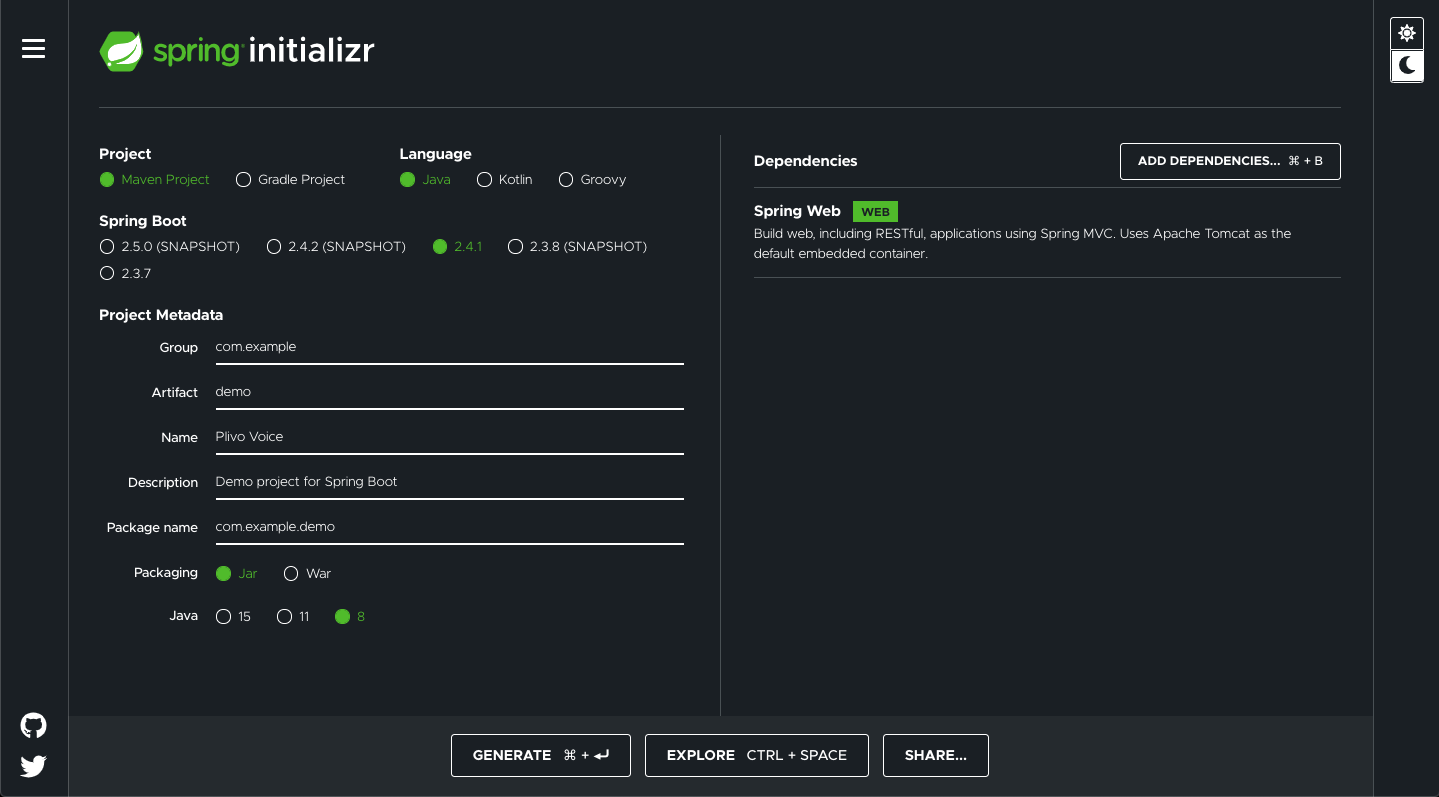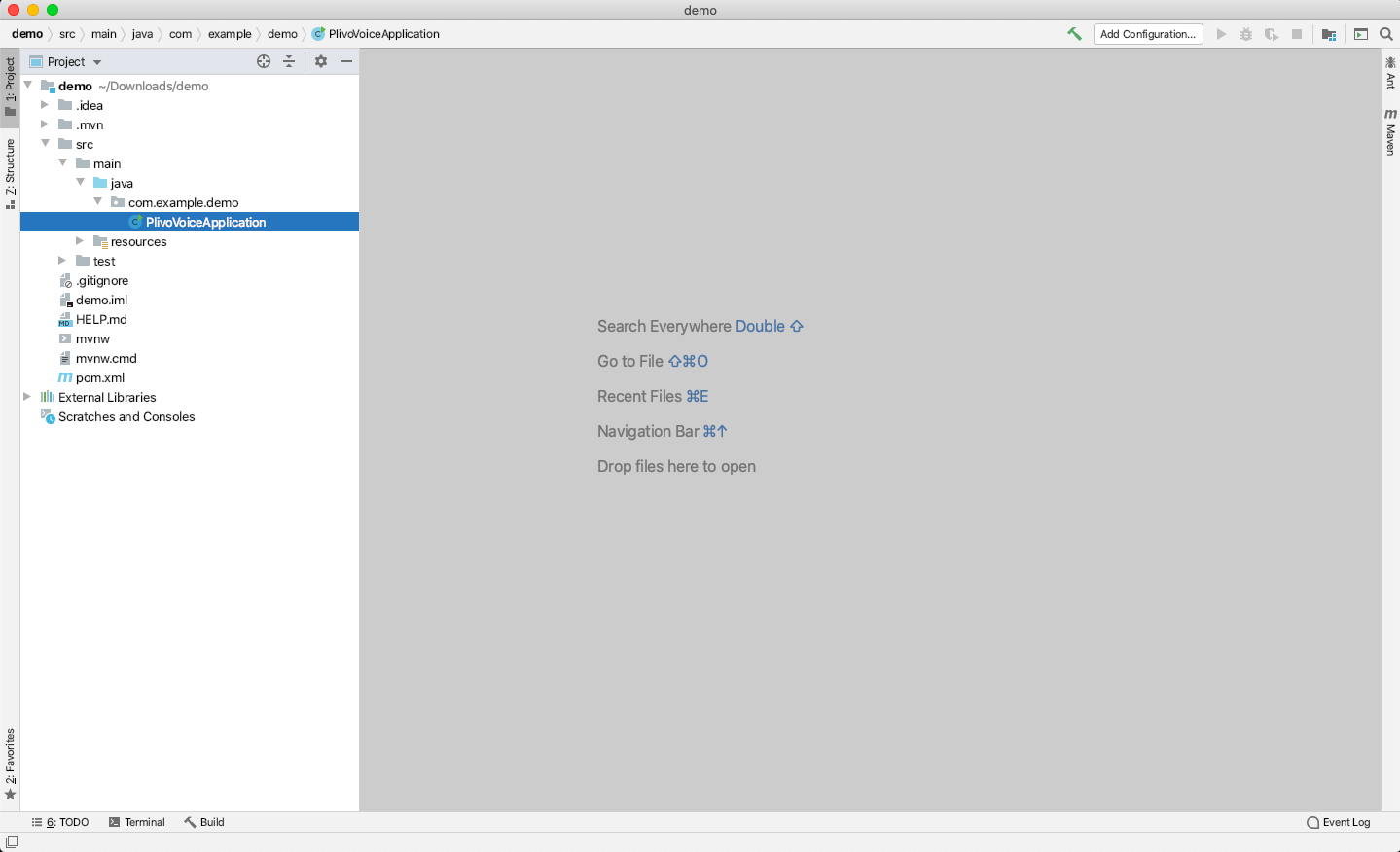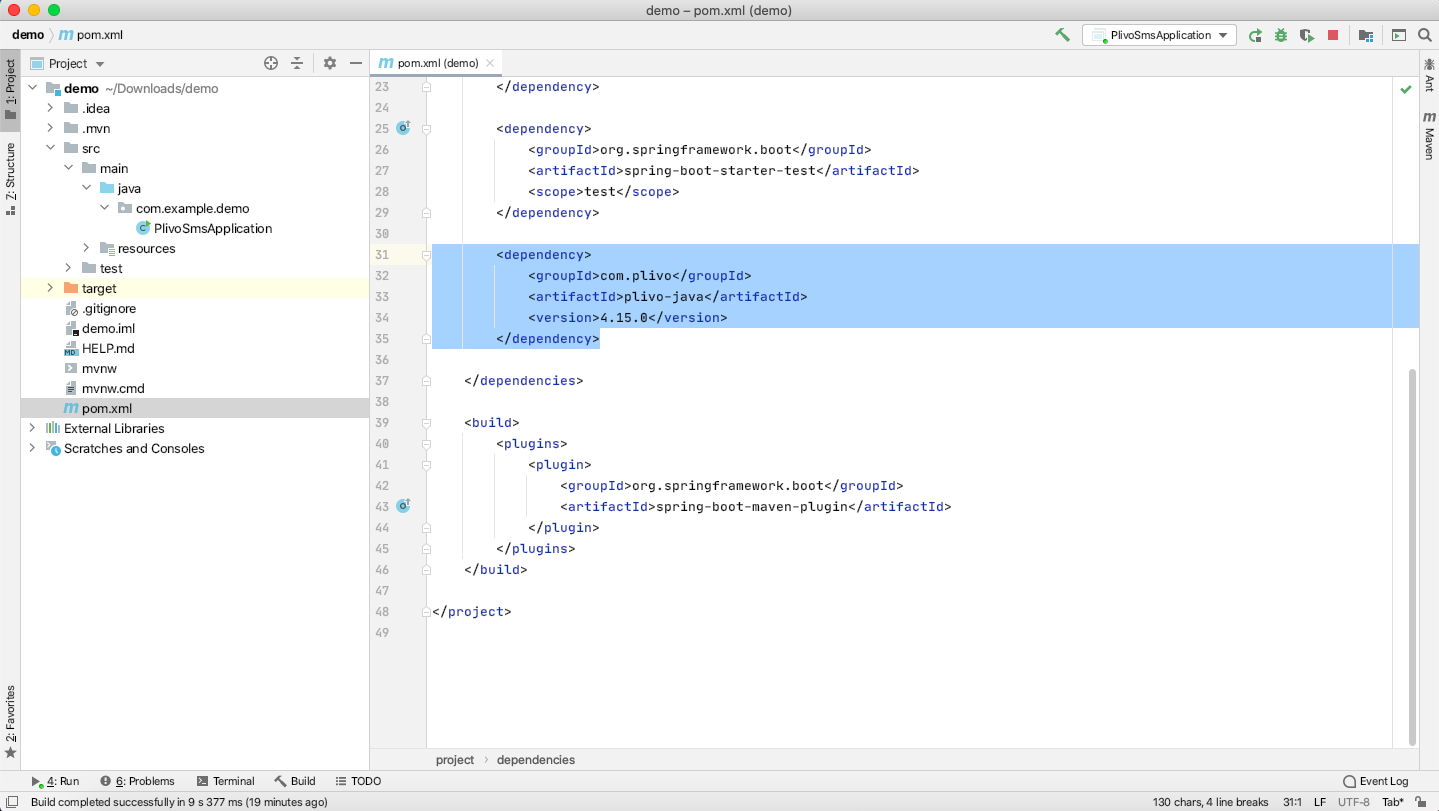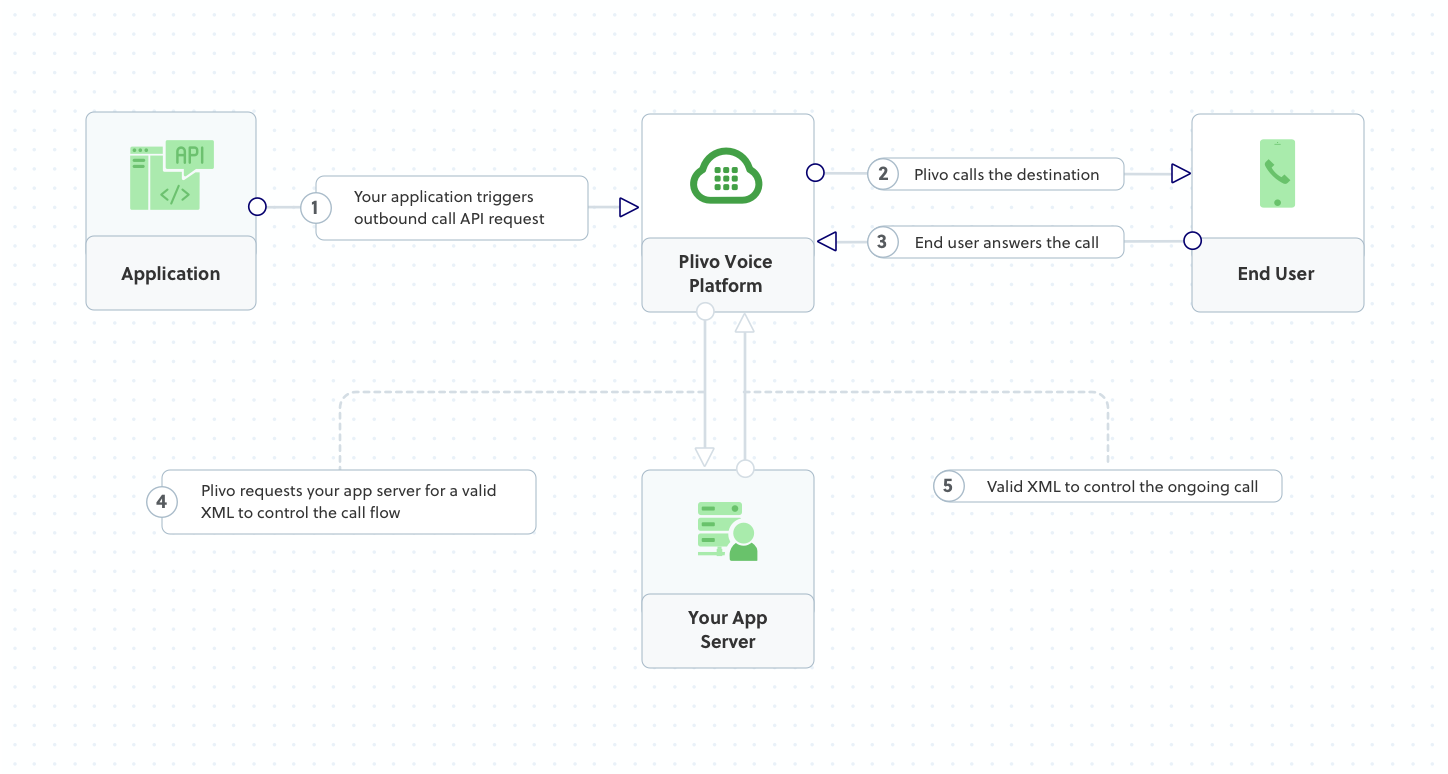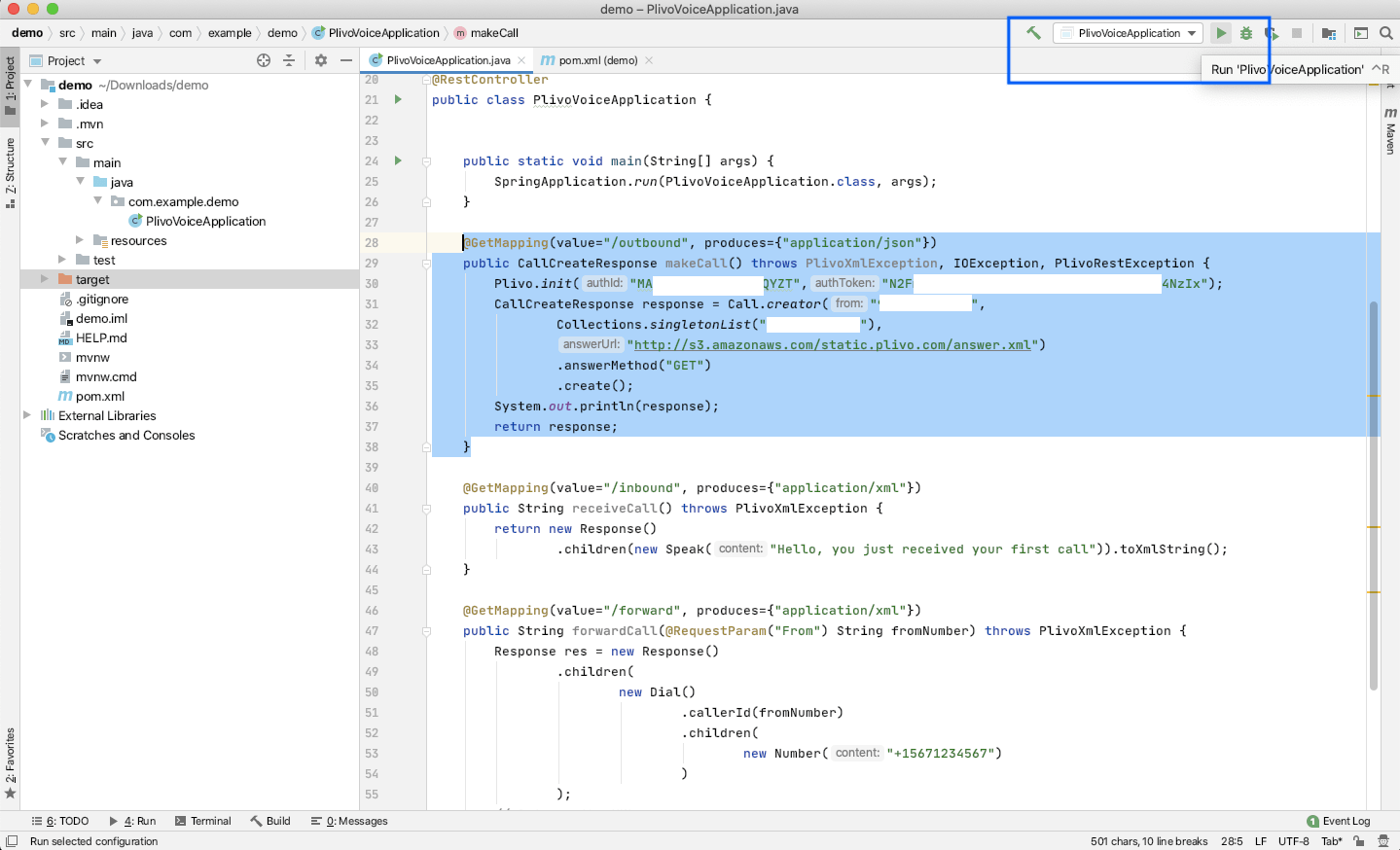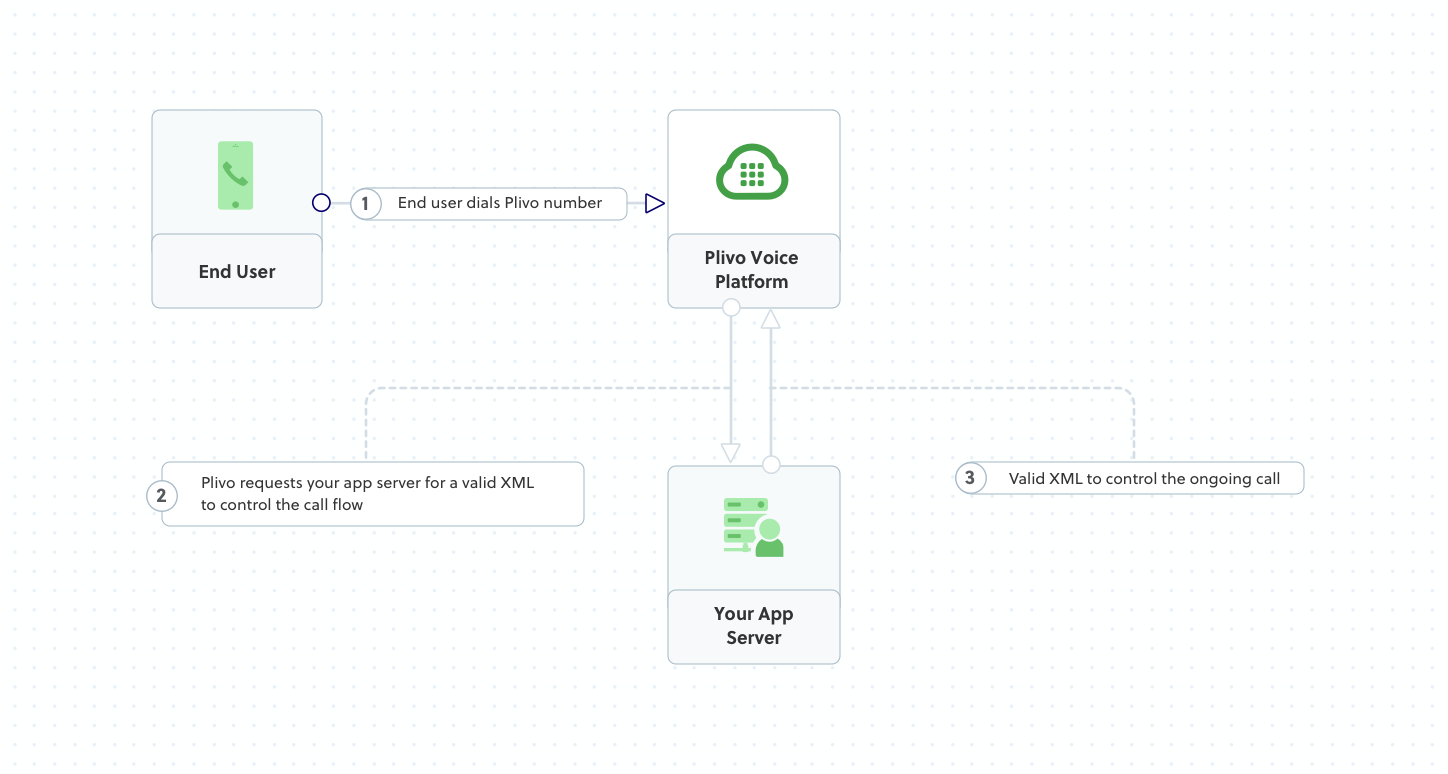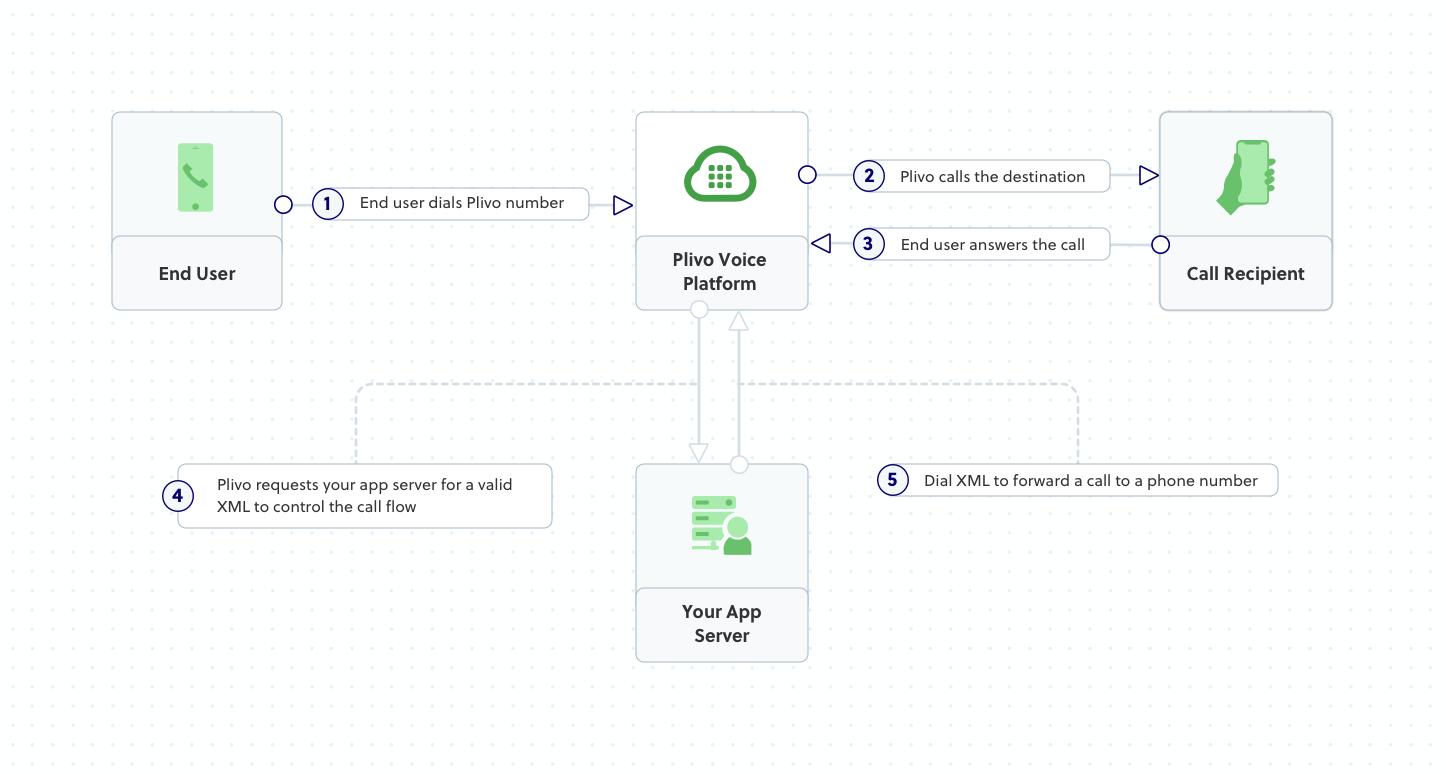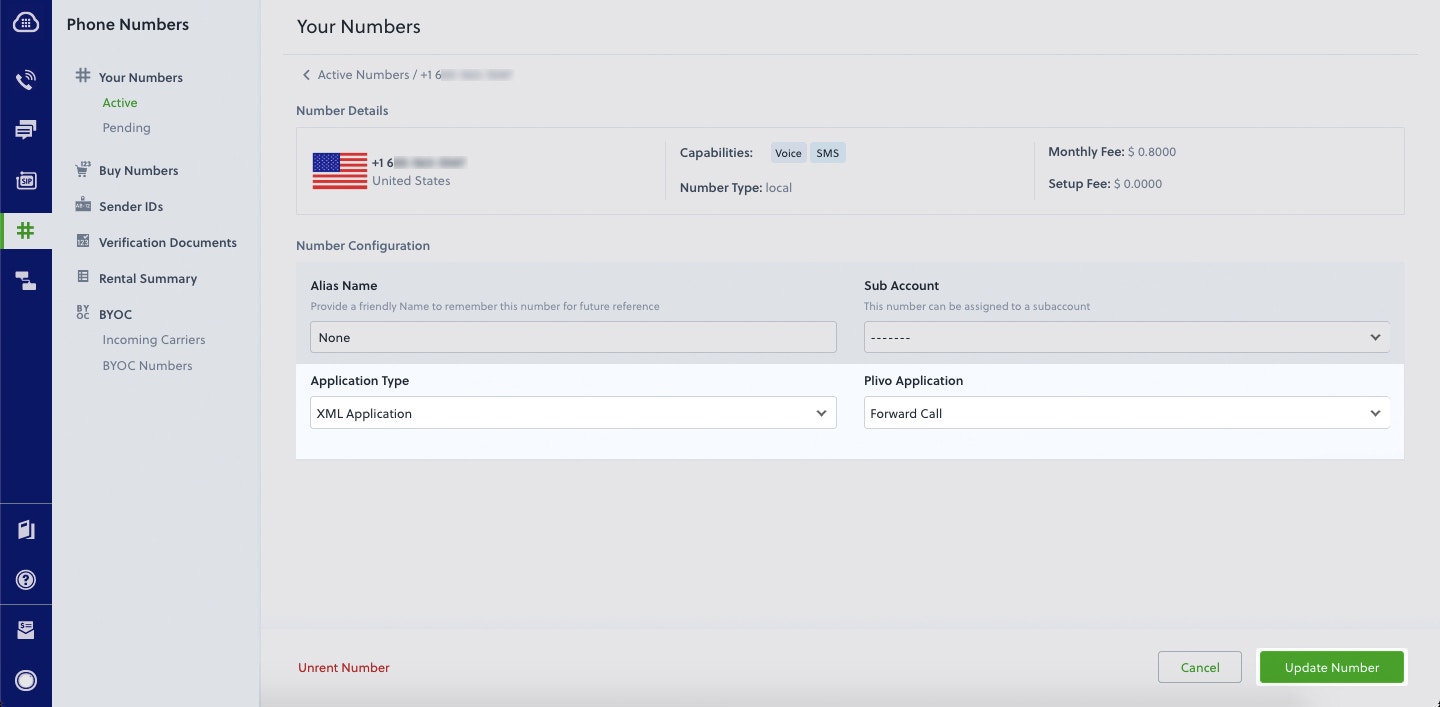Install Java, Spring, and the Plivo Java SDK
You must set up and install Java 1.8 or higher, Spring, and Plivo’s Java SDK before you make your first call.Install Java
You can check your Java version under macOS or Linux by running the command java -version in a terminal window. Under Windows there are several ways to check. If you don’t have Java installed or need a more current version, download and install it.You should also download and install IntelliJ Idea.Create a Spring application
Use Spring Initializr to create a boilerplate project with the Spring Boot framework.Choose the Spring Web dependency. Give the project a friendly name — we used Plivo Voice — and click Generate to download boilerplate code, which will be named PlivoVoiceApplication.java based on the friendly name we supplied. Open it in IntelliJ Idea.Install the Plivo Java SDK using IntelliJ Idea
Install the Plivo Java SDK by adding the dependency in pom.xml.<dependency>
<groupId>com.plivo</groupId>
<artifactId>plivo-java</artifactId>
<version>5.9.3</version>
</dependency>
Make your first outbound call
Plivo requests an answer URL when the call is answered (step 4) and expects the file at that address to hold a valid XML response from the application with instructions on how to handle the call. To see how this works, you can use https://s3.amazonaws.com/static.plivo.com/answer.xml as an answer URL to test your first outgoing call. The file contains this XML code:<Response>
<Speak>Congratulations! You've made your first outbound call!</Speak>
</Response>
Code
Edit the PlivoVoiceApplication.java file in src/main/java/com.example.demo/ and paste into it this code.package com.example.demo;
import com.plivo.api.Plivo;
import com.plivo.api.exceptions.PlivoRestException;
import com.plivo.api.models.call.Call;
import com.plivo.api.models.call.CallCreateResponse;
import org.springframework.boot.SpringApplication;
import org.springframework.boot.autoconfigure.SpringBootApplication;
import org.springframework.web.bind.annotation.GetMapping;
import org.springframework.web.bind.annotation.RestController;
import com.plivo.api.exceptions.PlivoXmlException;
import java.io.IOException;
import java.util.Collections;
@SpringBootApplication
@RestController
public class PlivoVoiceApplication {
public static void main(String[] args) {
SpringApplication.run(PlivoVoiceApplication.class, args);
}
@GetMapping(value="/outbound", produces={"application/json"})
public CallCreateResponse makeCall() throws PlivoXmlException, IOException, PlivoRestException {
Plivo.init("<auth_id>","<auth_token>");
CallCreateResponse response = Call.creator("<caller_id>",
Collections.singletonList("<destination_number>"),
"https://s3.amazonaws.com/static.plivo.com/answer.xml")
.answerMethod("GET")
.create();
System.out.println(response);
return response;
}
}
Note:
We recommend that you store your credentials in the auth_id and auth_token environment variables to avoid the possibility of accidentally committing them to source control. If you do this, you can initialize the client with no arguments and Plivo will automatically fetch the values from the environment variables. You can use System.getenv() to store environment variables and retrieve them when initializing the client.
Test
Save the file and run it.Receive your first inbound call
Plivo requests an answer URL when it answers the call (step 2) and expects the file at that address to hold a valid XML response from the application with instructions on how to handle the call. In this example, when an incoming call is received, Plivo’s text-to-speech engine plays a message using the Speak XML element.You must have a voice-enabled Plivo phone number to receive incoming calls; you can rent numbers from the Numbers page of the Plivo console, or by using the Numbers API.Set up a Spring application to handle incoming calls
Edit the PlivoVoiceApplication.java file in src/main/java/com.example.demo/ and paste this code into it after the makeCall function block.package com.example.demo;
import com.plivo.api.Plivo;
import com.plivo.api.exceptions.PlivoRestException;
import com.plivo.api.models.call.Call;
import com.plivo.api.models.call.CallCreateResponse;
import org.springframework.boot.SpringApplication;
import org.springframework.boot.autoconfigure.SpringBootApplication;
import org.springframework.web.bind.annotation.GetMapping;
import org.springframework.web.bind.annotation.RequestParam;
import org.springframework.web.bind.annotation.RestController;
import com.plivo.api.exceptions.PlivoXmlException;
import com.plivo.api.xml.Response;
import com.plivo.api.xml.Speak;
import java.io.IOException;
import java.util.Collections;
@SpringBootApplication
@RestController
public class PlivoVoiceApplication {
public static void main(String[] args) {
SpringApplication.run(PlivoVoiceApplication.class, args);
}
@GetMapping(value="/outbound", produces={"application/json"})
public CallCreateResponse makeCall() throws PlivoXmlException, IOException, PlivoRestException {
........;
........;
}
@GetMapping(value="/inbound", produces={"application/xml"})
public String receiveCall() throws PlivoXmlException {
return new Response()
.children(new Speak("Hello, you just received your first call")).toXmlString();
}
}
Note: Please update the import declaration section as well.
Expose your local server to the internet
To receive incoming calls, your local server must connect with Plivo API services. For that, we recommend using ngrok, which exposes local servers running behind NATs and firewalls to the public internet over secure tunnels. Using ngrok, you can set webhooks that can talk to the Plivo server.Install ngrok and run it on the command line, specifying the port that hosts the application on which you want to receive calls (80 in this case):This starts the ngrok server on your local server. Ngrok will display a forwarding link that you can use as a webhook to access your local server over the public network.Create a Plivo application to receive calls
Associate the controller you created with Plivo by creating a Plivo application. Visit Voice > Applications and click Add New Application. You can also use Plivo’s Application API.Give your application a name — we called ours Receive_call. Enter the server URL you want to use (for example https://<yourdomain>.com/receivecall/) in the Primary Answer URL field and set the method to POST. Click Create Application to save your application.Assign a Plivo number to your application
Navigate to the Numbers page and select the phone number you want to use for this application.From the Application Type drop-down, select XML Application.From the Plivo Application drop-down, select Receive Call (the name we gave the application).Click Update Number to save.Test
Make a call to your Plivo number using any phone.Forward an incoming call
Plivo requests an answer URL when the call is answered (step 4) and expects the file at that address to hold a valid XML response from the application with instructions on how to handle the call. In this example, when an incoming call is received, Plivo forwards the call using the Dial XML element.You must have a voice-enabled Plivo phone number to receive incoming calls; you can rent numbers from the Numbers page of the Plivo console, or by using the Numbers API.Set up a Spring application to forward calls
Edit the PlivoVoiceApplication.java file in src/main/java/com.example.demo/ and paste this code into it after the receiveCall function block.package com.example.demo;
import com.plivo.api.Plivo;
import com.plivo.api.exceptions.PlivoRestException;
import com.plivo.api.models.call.Call;
import com.plivo.api.models.call.CallCreateResponse;
import com.plivo.api.xml.Dial;
import org.springframework.boot.SpringApplication;
import org.springframework.boot.autoconfigure.SpringBootApplication;
import org.springframework.web.bind.annotation.GetMapping;
import org.springframework.web.bind.annotation.RequestParam;
import org.springframework.web.bind.annotation.RestController;
import com.plivo.api.exceptions.PlivoXmlException;
import com.plivo.api.xml.Response;
import com.plivo.api.xml.Speak;
import com.plivo.api.xml.Number;
import java.io.IOException;
import java.util.Collections;
@SpringBootApplication
@RestController
public class PlivoVoiceApplication {
public static void main(String[] args) {
SpringApplication.run(PlivoVoiceApplication.class, args);
}
@GetMapping(value="/outbound", produces={"application/json"})
public CallCreateResponse makeCall() throws PlivoXmlException, IOException, PlivoRestException {
........;
........;
}
@GetMapping(value="/inbound", produces={"application/xml"})
public String receiveCall() throws PlivoXmlException {
........;
........;
}
@GetMapping(value="/forward", produces={"application/xml"})
public String forwardCall(@RequestParam("From") String fromNumber) throws PlivoXmlException {
Response res = new Response()
.children(
new Dial()
.callerId(fromNumber)
.children(
new Number("<destination_number>")
)
);
// Returns the XML
return res.toXmlString();
}
}
Create a Plivo application to forward calls
Associate the Java application you created with Plivo by creating a Plivo application. Visit Voice > Applications in the Plivo console and click on Add New Application, or use Plivo’s Application API.Give your application a name — we called ours Forward Call. Enter the server URL you want to use (for example https://<yourdomain>.com/forward_call/) in the Answer URL field and set the method to POST. Click Create Application to save your application.Assign a Plivo number to your application
Navigate to the Numbers page and select the phone number you want to use for this application.From the Application Type drop-down, select XML Application.From the Plivo Application drop-down, select Forward Call (the name we gave the application).Click Update Number to save.Test
Make a call to your Plivo number using any phone. Plivo will send a request to the answer URL you provided requesting an XML response and then forward the call according to the instructions in the XML document the server provides.More use cases
We illustrate more than 20 use cases with code for both API/XML and PHLO on our documentation pages.